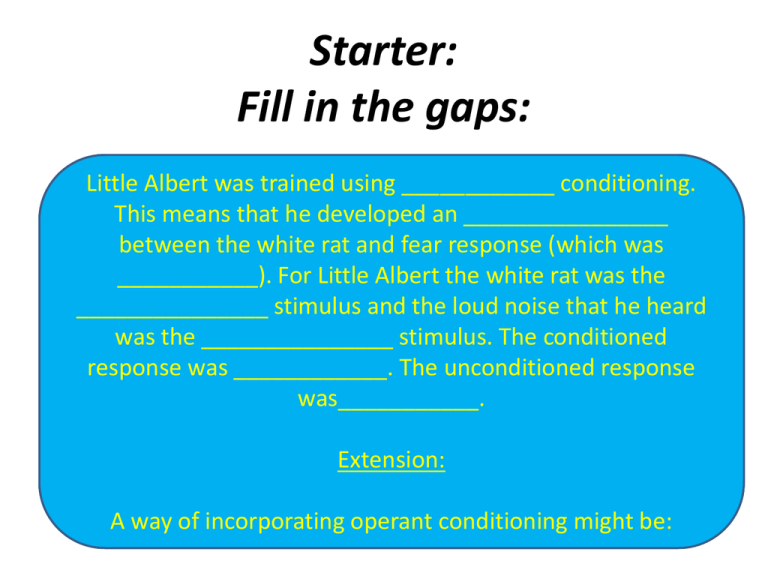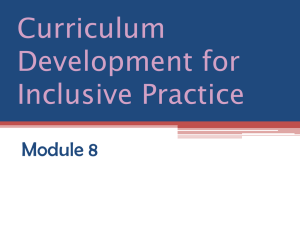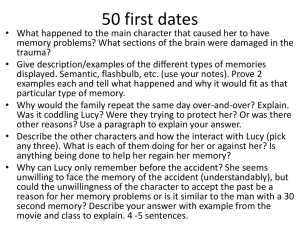Behavioural Therapies for Phobias
advertisement

Starter: Fill in the gaps: Little Albert was trained using ____________ conditioning. This means that he developed an ________________ between the white rat and fear response (which was ___________). For Little Albert the white rat was the _______________ stimulus and the loud noise that he heard was the _______________ stimulus. The conditioned response was ____________. The unconditioned response was___________. Extension: A way of incorporating operant conditioning might be: Behavioural Therapies Based on your understanding of behaviourist principles, how might they go about treating a phobia? Systematic desensitisation is based on the behaviourist assumption that the phobia has been learned wither through association (classical conditioning) or reinforcement (operant conditioning) and so can be unlearned based on the same principles. Phobias can be removed by counterconditioning – learning a new response to the feared stimulus. This is the principle behind Systematic Desensitisation. How it works: In the presence of the therapist, the client confronts each item in the hierarchy while they are in a state of deep relaxation. They start with the least feared item and move on once they feel relaxed and unafraid in its presence. This confrontation may be real or imagined. The process continues until they reach the top of the hierarchy and feel relaxed in the presence of all the items. Clients are taught relaxation techniques: 1 2 3 If the systematic desensitisation works, clients have been counter-conditioned – they have learnt a new response to a stimulus - relaxation. They no longer associate the object or situation with fear. McGrath (1990) **Behavioural perspective = behaviour is learnt and so has little to do with the individual and more to do with the situation they are in** • Behaviours such as phobias could be unlearnt (counterconditioned) • By pairing the phobic stimulus with something pleasant or relaxing, the treatment of phobias should be effective, and is known as systematic desensitisation • In terms of classical conditioning the fear response can be replaced by a conditioned response of calm • The stimulus that causes the fear is presented with something that makes the patient feel calm • Research by McGrath shows how successful the treatment can be for reducing phobias in a case study of a girl with a phobia of loud noises (ligyrophobia) Aim To treat a girl with specific noise phobias using systematic desensitisation Method: case study Design: single-participant Participant : • Lucy, a 9 year old girl who had a fear of sudden loud noises. These included balloons, party poppers, guns, cars backfiring and fireworks. • She had lower than average IQ, and was not depressed, anxious or fearful (tested with psychometric tests), so only had one specific phobia. Procedure Lucy was brought to the therapy session, Programme explained to parents They gave chosen for further session Session 1: Lucy constructed a hierarchy of feared noises. Inc: doors banging, guns, balloons and unexpected party poppers. • Taught breathing and imagery to relax • Told to imagine herself in bed at home with her toys • She had a hypothetical fear ‘thermometer’ to rate her level of fear from 1-10 As she was given the stimulus loud noise, she paired her feared object (loud noise) with relaxation, deep breathing and imagining herself at home with her toys. They started with the least fear inducing and worked up to the most. After 4 sessions she had learnt to feel calm when the noise was presented. She did not need to imagine herself at home with her toys anymore. Findings Session 1: • At the end of the first session, Lucy was reluctant to let balloons be burst even at the far end of the corridor. When the therapist burst the balloon anyway, Lucy cried and had to be taken away. • She was encouraged to breathe deeply and relax. 4th Session • By the end of the 4th session, Lucy was able to signal a balloon to be burst 10 metres away, with only mild anxiety Session 5 • Lucy held a deflated balloon, then a slightly inflated balloon and eventually was able to allow a small balloon to be burst in the consulting room. At the end of the session, Lucy was able to pop the balloons herself 6, 7 & 8 • Party poppers introduced and Lucy went from not allowing them into the consulting room to being able to pop one if the therapist held it • Cap guns were then introduced and were used outside, but Lucy was quickly able to agree to one being fired in the consulting room Session 10 • By Lucy’s 10th and final session, her fear thermometer scores had gone from 7/10 to 3/10 for balloons popping and 9/10 to 3/10 for party poppers; the cap gun had gone from 8/10 to 5/10 Lucy had control – she could say when and where noises were made, and controlled the use of inhibitors of the fear response which included relaxation and a playful environment. • Conclusion: It appears that noise phobias in children are amenable to systematic desensitisation. Evaluation • You will have evaluated the study for hwk. • In groups of 3, share your evaluations of the study. • Think about: • • • • • • Method Sample Issues – qual/quan, long/snap, ethics Reliability Validity Debates – free will/det, hol/reduc, nature/nur, ethno, psych a science • Usefulness Method & Data Collection • Case study – in depth and detailed • Case study – unique to Lucy • Controlled for extraneous/confounding variables such as depression, anxiety etc. • Did not manipulate the IV • Self-report, Lucy’s subjective experience • Self-report, may be subject to social desirability/demand characteristics. This lowers the internal validity of the study. • Used observation and self-report: triangulation of data – increases validity Sample • Unique case study on one participant, therefore cannot be generalised to all phobia sufferers Issues • • • • Ethics: Consent from parents Lucy in control Put in stressful situation Issues • Longitudinal vs snapshot • Longitudinal – able to see changes over time and the gradual removal of her fear Issues • Qualitative/ Quantitative • Both used • Rating scale (thermometer) subjective and open to interpretation • Replicable method • Observation: able to see her immediate response and see if her self-report and observations were in agreement Issues - validity • Low ecological validity • Not a natural environment – we do not know if the benefits transfer out of the clinical setting and into real life, where Lucy is not in control and stimuli are not predictable Issues - reliability • Cannot exactly replicate it as unique case • Thermometer and procedure is relatively standardised so could be replicated Debates • Nature vs nurture • Lends support to behavioural approach to phobias • They assume that nurture i.e. learning and environmental factors are the reason behind behaviour Reductionism • Reductionist as it boils down to stimulusresponse and does not take into account thought processes or feelings • This may be a good thing though, as Lucy was successfully treated Usefulness • Suggests that phobias can be counterconditioned and treated using systematic desensitisation • SD is in fact used to treat phobias • You have 2 useful info hand outs • The first one is a diagram that you should keep for your revision as it sums up the behavioural approach to phobias very neatly • The second one is an overview of the therapies used by behavioural psychologists and you can use it to help you with the following task. G1 Activity Extension: evaluate your treatment plan • Jen is terrified of cats • Her granny had a grumpy old cat, who used to bite and scratch her whenever she went round • She is desperate to be a vet, so she really needs to address the problem • Firstly – using the behavioural approach, explain why Jen is afraid of cats • Secondly – suggest a course of treatment for Jen G2 Extension: evaluate your treatment plan • Daniel has been terrified of dogs for over 7 months now. This is difficult for him as several of his friends have dogs and he finds he is avoiding going to their houses, so that he won’t encounter their dogs. • The last time he saw a dog was when one bounded towards him on his way home from school. As the dog got near him he froze; his face was white and he could not move. When the dog had gone he burst into tears and ran home. • Ever since that day he has avoided that road and taken a long way round that adds a mile to his walk home. • Firstly – using the behavioural approach, explain why Daniel is afraid of cats • Secondly – suggest a course of treatment for Daniel G3 Extension: evaluate your treatment plan • Cara is scared of loud noises • When she was younger, she ran out into the road • Luckily she was unhurt as the driver held his horn down and there was a piercing sound that alerted her • She was extremely startled and shaken by the sound • Firstly – using the behavioural approach, explain why Cara is afraid of cats • Secondly – suggest a course of treatment for Cara Homework • Plan the reliability and validity 15 mark questions using the resources provided. • You have a week to do this. • You do not have to write the essay. I will check your plans first and then you will choose one to write.







